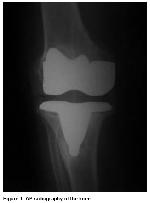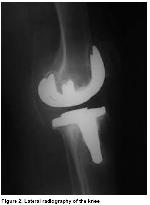 |
 |
| [ Ana Sayfa | Editörler | Danışma Kurulu | Dergi Hakkında | İçindekiler | Arşiv | Yayın Arama | Yazarlara Bilgi | E-Posta ] | |
| Fırat Tıp Dergisi | |||||
| 2008, Cilt 13, Sayı 2, Sayfa(lar) 153-155 | |||||
| [ Özet ] [ PDF ] [ Benzer Makaleler ] [ Yazara E-Posta ] [ Editöre E-Posta ] | |||||
| Brucellar Prosthetic Arthritis of the Knee Detected with the Use of Blood Culture System For the Culture of Synovial Fluid | |||||
| Emel Sesli ÇETİN1, Selçuk KAYA1, Tolga ATAY2, Mustafa DEMİRCİ1, Hüseyin YORGANCIGİL2 | |||||
| 1Süleyman DemirelÜniversitesi Tıp Fakültesi Mikrobiyoloji ve Klinik Mikrobiyoloji Anabilim Dalı, ISPARTA 2Süleyman DemirelÜniversitesi Tıp Fakültesi Ortopedi Anabilim Dalı, ISPARTA |
|||||
| Keywords: Brucellosis, prosthetic arthritis, blood culture system, Bruselloz, prostetik artrit, kan kültürü sistemi | |||||
| Summary | |||||
Late infection after arthroplasty is a rare, but one of the most serious problems complicating total joint replacement. Prosthetic infections caused by Brucella spp. are rarely described in the literature. In addition, the diagnosis of the disease is frequently difficult because of the slowly growing and fastidious nature of the bacterium. In recent years, blood culture systems have been introduced into clinical practice, and it has been demonstrated that this system may be a convenient tool for the culture of Brucellae from synovial fluid of patients with arthritis The patient who underwent a total joint replacement 4 years ago presented initially with symptoms suggestive of prosthetic knee infection. Brucellar monoarthritis of the knee was detected with the culture of the synovial fluid with blood culture system while no growth was detected on the conventional blood agar and chocolate agar plates. In conclusion, we emphasize the fact that Brucella infection of prosthetic joints should be considered in the differential diagnosis of prosthetic joint infection especially in endemic areas, and the diagnosis of Brucella arthritis may be underestimated when inappropriate culture media are used. ©2008, Firat University, Medical Faculty. |
|||||
| Introduction | |||||
Brucellosis is an infectious disease of animals that is transmitted to humans primarily by direct contact with infected animals tissues, ingestion of contaminated meats or dairy products, and inhalation of aerosolized organisms. Although effective control of brucellosis in animals and animal products has dramatically reduced the number of infections in developed countries, it is still an important public health problem, especially in Latin America, Africa, Asia and Mediterranean countries, including Turkey1. Arthritis is frequently observed in its course and may be one of the main presenting clinical features of the disease2. Peripheral articular pain, particularly of the large joints, is the commonest osteoarticular manifestation, while effusions that seldom yield organisms on culture, also occur frequently. Lack of awareness of this pattern of presentation could lead to misdiagnosis3. The diagnosis of the disease, however, is frequently difficult because brucellosis may mimic other clinical conditions such as rheumatic disorders, and thus, it should be confirmed by laboratory methods4. Staphylococci, streptococci and Gram negative bacilli have been reported to be the most common causative organisms in infections after arthroplasty. Prosthetic infections caused by Brucella spp. are rarely described in the literature5. In addition, cultures are often unsuccessful because of the slowly growing and fastidious nature of this bacterium. In recent years, blood culture systems have been introduced into clinical practice, resulting in reduced detection times. Experience accumulated with the BACTEC 9240 instrument has demonstrated that the system enables detection of B. melitensis from blood cultures within the routine 7-day incubation period4. Here, we report a case of brucellar monoarthritis of the knee, which underwent a total joint replacement 4 years ago, detected with blood culture system while no growth was detected on the conventional blood agar and chocolate agar media. |
|||||
| Case Presentation | |||||
A 72 year-old woman admitted to our hospital because of pain, swelling and restriction of movement in the right knee with 2 months duration. She had a medical history of Type II diabetes mellitus for 5 years and coronary artery disease for 2 years. She underwent a right total joint replacement 4 years ago because of advanced degenerative osteoarthritis of the knee. Vital parameters were normal. Neither toxic symptoms nor fever was registered on admission. Laboratory evaluation revealed hemoglobin of 12.8 g/dl; hematocrit of 34.4%; white blood cell count of 4900 cells/mm3; erythrocyte sedimentation rate of 34mm/h; CRP of 22.9 mg/dl. The results of serum chemistry were within normal limits. The right knee showed signs of local inflammation, swelling, sensitivity, crepitation and restriction of movement on physical examination. Radiography of the knee disclosed loosening of the tibial component with mild subsidence and a clear radiolucent line around the tibial implant (figure 1- 2).
Cefazolin (1g, 3x1, i.m.) was started and she underwent arthroscopic lavage and debridement with the initial diagnosis of prosthetic knee infection. Sero-purulent synovial fluid was obtained during arthroscopy and was sent to our laboratory in a closed sterile syringe immediately, demanding a conventional culture. The loosening of the tibial and femoral component was checked with probe and no revision was made. Villous synovial hypertrophy was observed during the arthroscopy and arthroscopic synovectomy was performed. In laboratory, synovial fluid was divided into two aliquots. One-half of the fluid (1.5 ml) was inoculated into an aerobic Peds Plus blood culture bottle and monitored by the BACTEC 9120 instrument (Becton Dickinson Diagnostic Instrument Systems, Sparks, MD, U.S.A.), and the second aliquot was plated onto sheep blood agar, chocolate agar, and MacConkey agar plates. After 3 days of incubation blood culture bottles were indicated as positive by the instrument. Detection of positive bottles was followed by performance of a Gram stain and subculture of the broth in sheep blood agar, chocolate agar, and MacConkey agar plates, and incubated at 350C in 5% CO2. After 48 h, minute translucent colonies were seen on blood agar plates. Gram stain from blood culture bottles and blood agar culture showed gram-negative coccobacillus that was catalase, oxidase, and urease positive within 3 minutes. These initial findings suggested the micro-organism to be Brucella spp. Further evaluation with Brucella antisera revealed that the bacterium was B. melitensis and the organism was confirmed as B. melitensis with VITEK II (Biomerieux, France) in a reference laboratory. After the isolation of Brucella in culture, the Brucella standard tube agglutination test was performed from the sera of the patient and it was positive, with a titre of 1/320. The patient was treated with doxycycline (2×100 mg/day orally) and rifampicin (1x 600mg /day orally) for 6 weeks. The symptoms slightly relieved, and she was discharged with the suggestion of weekly follow-ups comprising tube agglutination + liver enzyme level controls. A year later, the patient remained free of knee pain and able to perform her daily activity. No epidemiological information could be obtained regarding the source of the infection. No previous contact with livestock or dairy products was reported. |
|||||
| Discussion | |||||
Late infection after arthroplasty is important to diagnose early and treat on an urgent basis. Prosthetic infections due to Brucella spp. are extremely rare and since they are slow-growing organisms and require special culture conditions, the laboratory should be warned that Brucellae are suspected6. Definitive diagnosis of this infection is based on the culture of Brucella spp. from synovial fluid samples, but detection of the organism in clinical specimens is frequently hampered by its slow growth. On the basis of experience gained with traditional methods, incubation of cultures for 30 days has been advocated to maximize the recovery of these fastidious organisms7. In recent years, the use of blood culture systems for the culture of normally sterile body fluids other than blood has gained increasing approval, resulting in increased recovery rates and shortened detection periods for Brucella. Yagupsky et al have reported that the aerobic Peds Plus BACTEC blood culture bottles may be a convenient tool for the culture of Brucellae from synovial fluid of patients with arthritis4. Our patient presented initially with symptoms suggestive of prosthetic knee infection, but Brucella was not suspected on preoperative evaluation. To our knowledge according to pub med scanning, there are 3 previous reports of prosthetic knee infection5,8,9. Our patient is the fourth case reported in the literature of a Brucella infection involving prosthetic knee, and the diagnosis was recognized postoperatively with the use of blood culture system for the culture of synovial fluid taken during arthroscopic surgery. Since the diagnosis was not suspected on preoperative evaluation, laboratory was not warned that Brucellae are suspected. This is not surprising since brucellosis has a variable and a wide spectrum of clinical manifestations and only searching for it when suspicious exposure exists, may lead to identification. Moreover, the laboratory data may usually be normal, making the diagnosis of brucellosis difficult for the physician1. So, we would not be able to isolate the causative pathogen in this case, if we did not use the blood culture system besides conventional methods. In conclusion, we emphasize the fact that Brucella infection of prosthetic joints should be considered in the differential diagnosis of prosthetic joint infection especially in endemic areas, so determination of Brucella titers preoperatively is warranted in these patients and the diagnosis of Brucella arthritis may be underestimated when inappropriate culture media are used. |
|||||
| References | |||||
1) Ibero I, Vela P, Pascual E. Arthritis of shoulder and spinal cord compression due to Brucella disc infection. British Journal of Rheumatology 1997; 36: 377-381.
2) Kasim RA, Araj GF, Afeiche NE, Tabbarah ZA. Brucella infection in total hip replacement: case report and review of the literature. Scand J Infect Dis 2004; 36: 65-67.
3) Rajapakse CN: Bacterial infections: osteoarticular brucellosis. Baillieres Clin Rheumatol. 1995; 9: 161-177.
4) Yagupsky P, Peled N, Press J. Use of BACTEC 9240 Blood Culture System for Detection of Brucella melitensis in Synovial Fluid J Clin Microbiol 2001; 39: 738739.
5) Orti A, Roig P, Alcala R, Navarro V, Salavert M, Martin C, Zorraquino A, Merino J. Brucellar prosthetic arthritis in a total knee replacement. Eur J Clin Microbiol Infect Dis 1997; 16: 843-845.
6) Pascual E. Brucellar arthritis. In: Maddison PJ, Isenberg DA, Woo P, Glass DN (eds). Oxford textbook of rheumatology. Oxford University Pres, 1993: 581-582.
7) Moyer NP, Holcomb LA . Brucella. In: Murray PR, Baron E J, Pfaller MA, Tenover FC, Yolken RH, eds. Manual of clinical microbiology. 6th ed. Washington, D.C.: American Society for Microbiology, 1995: 549555.
|
|||||
| [ Başa Dön ] [ Özet ] [ PDF ] [ Benzer Makaleler ] [ Yazara E-Posta ] [ Editöre E-Posta ] | |||||
| [ Ana Sayfa | Editörler | Danışma Kurulu | Dergi Hakkında | İçindekiler | Arşiv | Yayın Arama | Yazarlara Bilgi | E-Posta ] |

